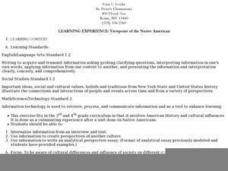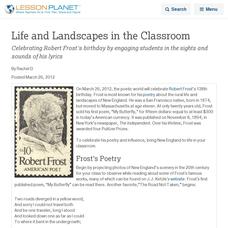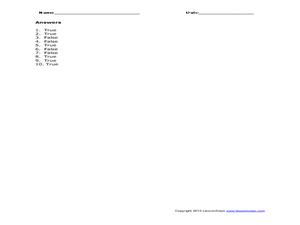Annenberg Foundation
Utopian Promise
Scholars learn all about the Puritans in the third installment of a 16-part lesson series. After watching a video, they read and discuss biographies of Puritans and Quakers from American history, write journal entries and poetry, and...
Curated OER
1704 Attack on Deerfield
Class groups examine conflicting primary and secondary sources describing the 1704 attack on the fort at Deerfield by French and Native Americans and analyze the implications of discrepancies.
Curated OER
Viewpoint of the Native American
Students compare how Native Americans were treated long ago to how they are treated today. They write an essay from the perspective of a Native American from their time period explaining their side with details supporting their views.
Curated OER
"Some Excellent Dumb Discourse:" Caliban as native American
Explore The Tempest and how language and power are intertwined in the play. Through a series of questions (provided) and an intense activity that has groups translate Caliban's speech into American Sign Language, learners recognize...
Curated OER
Kernels of Wisdom: Investigating Natural Variations in Corn
Here is a brain-popper! Corn, or more appropriately, maize, was intentionally domesticated by humans around 9,000 years ago and over a period of hundreds to thousands of years! Genetics and botany researchers have collaborated to find...
New York City Department of Education
Geography and Early Peoples of the Western Hemisphere
Young historians discover the early people of the western hemisphere. The unit explores how the land changed, how it was used and homes of early Americans such as Incas, Mayans, Inuits, Aztecs, and Pueblos. Individuals also examine these...
K12 Reader
Conflict Over North American Lands
Readers are introduced to some of the conflicts that arose over land and resources in the Americas in a two-part cross-curricular comprehension worksheet that asks kids to study the article and then to use information provided to respond...
Curated OER
Declarations of Independence
Learners examine what they know about American Indians past and present, then research key issues facing American Indian tribes today. To synthesize their learning, students write letters taking the perspective of an American Indian.
Curated OER
Intermediate Level Lesson Plan THEMATIC ESSAY
Students identify three reasons why conflict arose in the Western United States during the late 1800s. Using specific examples, discuss how the United States government attempted to resolve these conflicts. Evaluate whether these...
Curated OER
Survival of Native American Culture
Students research the five tribes of the Iroquois Nation focusing on housing, food, clothing, transportation, religion, and language. They research using Internet sources and book mark sites for reuse.
Curated OER
Life and Landscapes in the Classroom
Celebrating Robert Frost's birthday by engaging students in the sights and sounds of his lyrics
Curated OER
The Finish Line
Students investigate the philanthropy of various cultural traditions. In this cultural education lesson, students read a handout about Native American, European American, and African American traditions and identify the philanthropic...
Curated OER
Pooling Common Knowledge
Fifth graders examine Native American cultures. In this diversity lesson, 5th graders prepare oral reports based on the research they conduct regarding Native American clothing, holidays, and sports.
Curated OER
Westward Expansion: Chief Joseph's Words Of Surrender
Students explore westward expansion in the United States as it relates to Native Americans and the novel Holes. Students read a passage from Holes and discuss how westward expansion affected the Native Americans. Students compare and...
Curated OER
Global Diversity Through Literature
Students investigate Southwest Indian Reservations. In this Native American lesson, students research Southwest Indian tribes on the Internet and by reading the book, Arrow to the Sun.
Curated OER
Breathing New Life into Old Traditions
Learners investigate the role of ceremonies and other traditions of Native American cultures. They research various Native American nations and create posters that visually depict their research.
Curated OER
Searching the Net
Students create a Native American Nation flip book. In this Native American lesson, students choose one of four Native American Nations: The Iroquois, Hopi, Seminoles, Sioux. They research them on the Internet using teacher given...
Curated OER
American Indians
In this American Indians worksheet, students read a 2 page article on American Indians, answer 6 statements as true or false and fill in 8 blanks in 8 facts referring back to American Indians.
City University of New York
African Americans and the Populist Movement
Why did the Populist Party fail to ally itself with African American farmers? To answer this essential question, class members investigate the Populist Era (188-1900) and read an article written by Tom Watson, a Populist leader.
Curated OER
Early Native Americans
Fourth graders locate on a globe where the land bridge was. They describe the progression of nomadic people into North America.
NYC Department of Records
Citizenship and Elections: The Importance of a Ballot
Approximately 58 prcent of those eligible voted in the 2016 US Presidential election. In an attempt to impress upon learners the importance of voting and voting rights, class members examine primary source documents related to the...
Curated OER
Cruising the Harbor
Students read original, primary source account of coming into New York's harbor, compare harbor experiences of Native Americans and Europeans, and explore role of African Americans in waterfront and seafaring activities in New York's...
Curated OER
Town Growth and Immigration
Fourth graders describe how Michigan has changed and stayed the same over time. They explain reasons why people settled/settle in Michigan, then explain the role of geography on the settlement of Michigan.
Curated OER
New Jersey
In this reading comprehension worksheet, students read a passage about the early history of the state of New Jersey and answer true and false questions. Students write 10 answers.

























